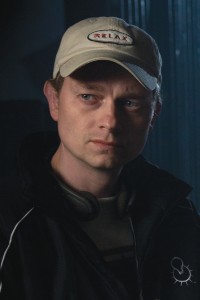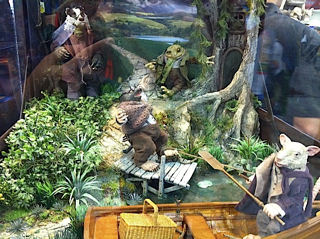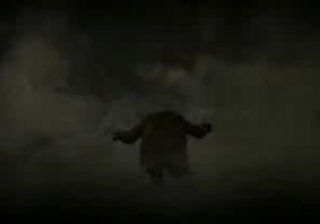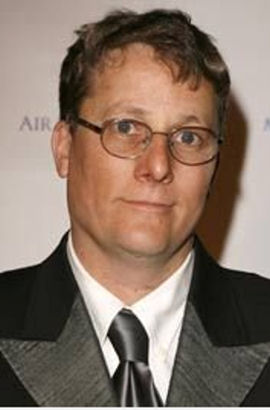|
Comic-Con
2010:
A Mighty Wind
| |
| Writer/Director
Ray Griggs |
Back
at WonderCon 2009, Lon Lopez and Derek McCaw met up with
a filmmaker named Ray Griggs, there promoting an upcoming
superhero parody/love letter called SuperCapers. A relatively
young director betting the farm on his career, Ray impressed
us with his earnestness and obvious passion for filmmaking.
SuperCapers
never made it to the Bay Area, but it was a great pleasure
to see Ray's name attached to an intriguing project. New
Zealand special effects house (and maker of fine film collectibles)
Weta was producing its own adaptation of Kenneth Grahame's
The Wind in the Willows, and there was Ray's name as writer
and director.
At
Comic-Con, we sent freelance journalist Lyz Reblin to talk
to Ray and Richard Taylor, one of Weta's founders and a
five-time Academy Award winner for visual effects. Taylor
was only able to spare Lyz a moment or two, but we're just
glad that she got some insight into this cool project based
on a classic children's novel.
Ray
had also been scheduled to expand his short film Lucifer
into a full-length feature, and so Lyz begins there...
LYZ
REBLIN: How is your personal project,
Lucifer, going?
RAY
GRIGGS: That is shelved temporarily. As an independent
guy you have to climb the ropes and with Lucifer,
working with Weta, breaking that down it has more visual
effects than King Kong so it has a tremendous amount
of budget. So that means to do it right I have to wait for
the technology to catch up with what I want to do in this
film.
| |
| A
still from the short film version of Lucifer... |
LYZ
REBLIN: Like Star Wars, where George Lucas
had to wait to do Episode 1?
RAY
GRIGGS: Exactly. Some of the things I want to
do have never been achieved before on camera, amazing as
that sounds.
I’ve
had to put it off for a little bit, and in the meantime
been building my career and doing other projects till I
get back to that.
LYZ
REBLIN: Is that how you got together with Richard
Taylor, through Lucifer?
RAY
GRIGGS: It is. I started with Weta digital about
five years ago with Lucifer. They were amazing
people, really great, friendly, hardworking. Their imaginations
are like a bunch of kids running around. It’s really
a treat to work with them.
LYZ
REBLIN: Why remake Wind in the Willows, when it
has been done so many times?
| |
| All
we've seen of Toad... |
RAY
GRIGGS: Everybody has had a unique way of making
it. But I don’t think anyone has attempted to do it
to the level that we are doing it. As you know there was
a cartoon version by Disney, but that was a short. Then
there was a claymation one for TV. Terry Gilliam did one
for TV as well where everyone (Toad) is just painted green.
This one is dealing with animatronics, live action. So it’s
really going to open up the world, make it epic.
LYZ
REBLIN: What was your first introduction
to Wind in the Willows?
RAY
GRIGGS: I was eight years old, over in Germany;
I grew up in there. I read this story and I walked away
loving the story but had tons of questions. So that was
my inspiration when taking a stab at the script, answering
some of these questions in the book and making sense of
it all and enjoying the beauty of the Edwardian era that
this story holds.
LYZ
REBLIN: What’s the tone you’re going
for with this film?
RAY
GRIGGS: It’s definitely both for kids and
adults.
One
of the things we did in a test short was we did one of the
most advanced animatronics out there. It had 58 servos in
the head alone, gears and motors to make the head turn.
There’s puppetry like Where the Wild Things Are.
| |
| Weta
debuted character designs at Comic-Con
in the Dark Horse Booth. |
The
challenge you have with animatronics is you have a lot of
trouble on sets. Servos are breaking down and all sorts
of things. But it creates a different look than you see
today.
Everybody
is so accustomed to digital animation that when you see
these characters on screen you feel the weight these characters
have. Now CG animation is good for some films, like in Avatar,
that’s just epic and beautiful in its own way. But
I think there is a beauty of taking an old technology like
animatronics.
Take
Return of the Jedi, it holds up really well today
and that’s all animatronics and models. So same thing,
you just take that same technology, update it for today,
and create a film like the Wind in the Willows.
LYZ
REBLIN: So why did you choose to do Wind in the
Willows now? You read it when you were eight years old,
what inspired you now?
RAY
GRIGGS: I was kind of in between projects, trying
to find something to do. I just happened to start this thing
and everything seemed to stumble and snowball, and I was
able to get it off the ground.
I am
just trying to make a mark in the industry. What movie is
going to be my breakout film, so I I can eventually do something
like Lucifer?
LYZ
REBLIN: You wrote this as well?
RAY
GRIGGS: Yes, I did.
LYZ
REBLIN: What’s your process when
you’re writing?
RAY
GRIGGS: I have a funny process. I like to surround
myself in my room with ocean music or whatever is on the
subject matter I’m working on. For Wind in the
Willows I had a lot of forest music in there and eerie
sounds. It helps develop and inspire me by the wild woods,
the creepy and dark part of the story. I just use different
sound effects to get me into that environment.
LYZ
REBLIN: What was the biggest difficulty
in adapting the book?
RAY
GRIGGS: Deciding what is the arc that people like
to look for in cinema. The beauty of Wind in the Willows
is that it was written by Kenneth Graham and he did such
a wonderful job at that. I was actually surprised most studios
hadn’t done this yet, because it had every aspect
of Alice in Wonderland or Tolkien’s Lord
of the Rings or Narnia.
It has
this great rich epic story, a lot of action and everything
else involved. Because Toad is the wind in the willows,
he’s disrupting this perfect place. For me, it’s
like what is going to grab the people and how are we going
to take this story and arc it and have people walk away
with something and have morals to it.
LYZ
REBLIN: Who's your favorite character from Wind
in the Willows?
RAY
GRIGGS: I have to say Mole. Mole lived like a
hermit. And if you remember from the book, he burrows out
of his hole and all of a sudden he’s this little tiny
child where everything is new to him, full of excitement.
I tend to relate to him. I can see myself just loving the
industry and everything is new and exciting.
(Richard
Taylor has a free moment...)
LYZ
REBLIN: So tell us your side of how you
two got together, Mr. Taylor?
RICHARD
TAYLOR: Well, Griggs kindly wrote to us when he
was trying to get a feature film off the ground and asked
us if we would do a budget on it, which we did. That got
us talking. Unfortunately that one didn’t happen,
but he said next time I get something off the ground I’ll
come back to you. And that’s exactly what he did now.
LYZ
REBLIN: Why animatronics over digital?
RAY
GRIGGS: I wanted to tell the story in a unique
way. Today’s society you just naturally go to digital.
I don’t have a massive $150 million studio budget
to pull something off, so I have to be creative in how I
do it to keep within the budget.
Artistically,
because it’s such an epic story and old-fashioned,
I felt that this was one way of doing it that hasn’t
been done before. Let’s give something new to the
audience that has a uniqueness of its own.
LYZ
REBLIN: Which film has been the biggest challenge
for Weta?
RICHARD
TAYLOR: I’d hate to call it a problem; it’s
more a creative challenge. That’s exactly what we
want from jobs. Technical and artistic challenges that push
you to the limits of your capabilities and hopefully you
deliver something.
Every
new film progressively has more intriguing challenges on
it because even the smaller budget pieces we do, because
we never want to do something we’ve done before, we’re
always trying to push.
This
one will be the hardest we have done on the animatronics
level and we will test ourselves to the limit on it. And
all going well, will fulfill Ray’s expectations.
And
now we have our expectations -- looking forward to The Wind
in the Willows in 2012!
-
Lyz Reblin
Contact
Us!
|










